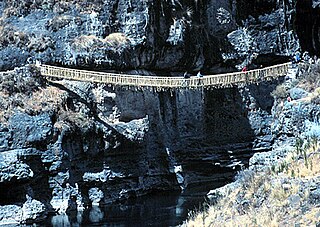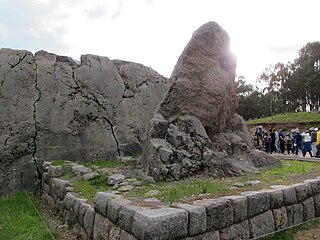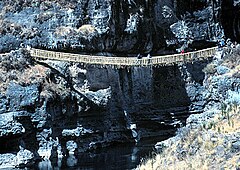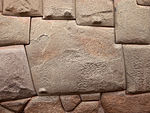
The Inca Empire, called Tawantinsuyu by its subjects, was the largest empire in pre-Columbian America. The administrative, political, and military center of the empire was in the city of Cusco. The Inca civilization rose from the Peruvian highlands sometime in the early 13th century. The Spanish began the conquest of the Inca Empire in 1532 and by 1572, the last Inca state was fully conquered.

A suspension bridge is a type of bridge in which the deck is hung below suspension cables on vertical suspenders. The first modern examples of this type of bridge were built in the early 1800s. Simple suspension bridges, which lack vertical suspenders, have a long history in many mountainous parts of the world.

The Inca road system was the most extensive and advanced transportation system in pre-Columbian South America. It was about 40,000 kilometres (25,000 mi) long. The construction of the roads required a large expenditure of time and effort.

A simple suspension bridge is a primitive type of bridge in which the deck of the bridge lies on two parallel load-bearing cables that are anchored at either end. They have no towers or piers. The cables follow a shallow downward catenary arc which moves in response to dynamic loads on the bridge deck.

A chasqui was a messenger of the Inca empire. Agile, highly trained and physically fit, they were in charge of carrying messages –in the form of quipus or oral information– and small packets. Along the Inca road system there were relay stations called chaskiwasi, placed at about 2.5 kilometres (1.6 mi) from each other, where the chasqui switched, exchanging their message(s) with the fresh messenger. The chasqui system could be able to deliver a message or a gift along a distance of up to 300 kilometres (190 mi) per day.

Felipe Guamán Poma de Ayala, also known as Huamán Poma or Waman Poma, was a Quechua nobleman known for chronicling and denouncing the ill treatment of the natives of the Andes by the Spanish Empire after their conquest of Peru. Today, Guaman Poma is noted for his illustrated chronicle, El primer nueva corónica y buen gobierno.

Inca architecture is the most significant pre-Columbian architecture in South America. The Incas inherited an architectural legacy from Tiwanaku, founded in the 2nd century B.C.E. in present-day Bolivia. A core characteristic of the architectural style was to use the topography and existing materials of the land as part of the design. The capital of the Inca empire, Cuzco, still contains many fine examples of Inca architecture, although many walls of Inca masonry have been incorporated into Spanish Colonial structures. The famous royal estate of Machu Picchu is a surviving example of Inca architecture. Other significant sites include Sacsayhuamán and Ollantaytambo. The Incas also developed an extensive road system spanning most of the western length of the continent and placed their distinctive architecture along the way, thereby visually asserting their imperial rule along the frontier.

Písac or Pisac is a Peruvian town in the Sacred Valley of the Incas. It is situated on the Vilcanota River. Pisac is most known for its Incan ruins and large market which attracts heavy tourist traffic from nearby Cusco.

The Inca society was the society of the Inca civilization in Peru. The Inca Empire, which lasted from 1438 to 1533 A.D., represented the height of this civilization. The Inca state was known as the Kingdom of Cusco before 1438. Over the course of the empire, the rulers used conquest and peaceful assimilation to incorporate a large portion of western South America, centered on the Andes mountain ranges. The empire proved relatively short-lived however: by 1533, Atahualpa, the last Sapa Inca (emperor) of the Inca Empire, was killed on the orders of the conquistador Francisco Pizarro, marking the beginning of Spanish rule. The last Inca stronghold, the Neo-Inca State in Vilcabamba, was conquered by the Spanish in 1572.
The term Peruvian literature not only refers to literature produced in the independent Republic of Peru, but also to literature produced in the Viceroyalty of Peru during the country's colonial period, and to oral artistic forms created by diverse ethnic groups that existed in the area during the prehispanic period, such as the Quechua, the Aymara and the Chanka South American native groups.

The Inca Bridge or Inka Bridge refers to one of two places related to access to Machu Picchu, in Peru.

Choquequirao is an Incan site in southern Peru, similar in structure and architecture to Machu Picchu. The ruins are buildings and terraces at levels above and below Sunch'u Pata, the truncated hill top. The hilltop was anciently leveled and ringed with stones to create a 30 by 50 m platform.

Inca technology includes devices, technologies and construction methods used by the Inca people of western South America, including the methods Inca engineers used to construct the cities and road network of the Inca Empire.

A kuraka, or curaca, was an official of the Inca Empire who held the role of magistrate, about four levels down from the Sapa Inca, the head of the Empire. The kurakas were the heads of the ayllus. They served as tax collector, and held religious authority, in that they mediated between the supernatural sphere and the mortal realm. They were responsible for making sure the spirit world blessed the mortal one with prosperity, and were held accountable should disaster strike, such as a drought. Kurakas enjoyed privileges such as being exempt from taxation, the right to polygamy and to ride in a litter.
The Chanka people are a Quechua people ethnic group living in the regions of Apurímac, Ayacucho and Lamas of Peru. They were enemies of the Incas, and they were centered primarily in Andahuaylas, located in the modern-day region of Apurímac. The Chankas were divided into three groups: the Hanan Chankas, or the Upper Chankas, the Urin Chankas, or the Lower Chankas, and the Villca, or Hancohuallos. The Hanan Chankas had their center in Andahuaylas, the Urin Chankas in Uranmarca, and the Villca in Vilcas Huaman, Ayacucho.

Q'enqo, Qenko,Kenko, or Quenco is an archaeological site in the Sacred Valley of Peru located in the Cusco Region, Cusco Province, Cusco District, about 6 km north east of Cusco. The site was declared a Cultural Heritage (Patrimonio Cultural) of the Cusco Region by the National Institute of Culture.

Yanaca is a group of ancient, pre-Incan towns located in Peru in Apurimac Region, Aymaraes Province, Yanaca District. These towns were located in the area surrounding the present-day town of Yanaca in the Andes mountain range, between the Quechua and Suni regions.

Queshuachaca, is the last remaining Inca rope bridge, consisting of grass ropes that span the Apurimac River near Huinchiri, in Quehue District, Canas Province, Peru.
Victoriano Arizapana Huayhua is a Quechua master rope bridge engineer, notable for being the lead builder of the Q'iswa Chaka, which is the last remaining traditionally built Inca rope bridge and a part of the historical Qhapaq Ñan Inca road network. He is also a teacher and cultural figure, preserving and transmitting to future generations the bridgebuilding techniques passed to him by his ancestors.

The economy of the Inca Empire was based on local traditions of solidarity and mutualism, transported to an imperial scale. It was based on the institution of reciprocity, considered the socioeconomic and political system of the Pre-Columbian Andes.

























